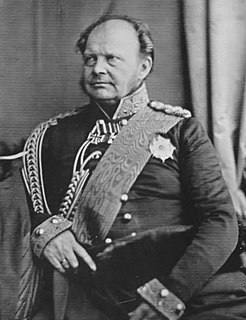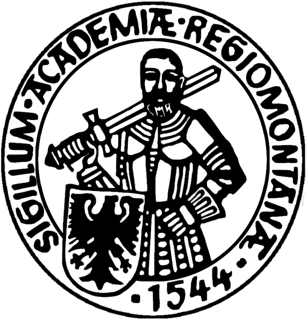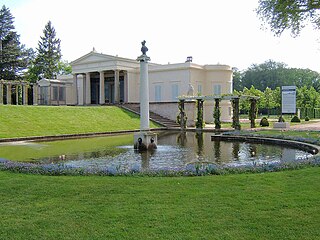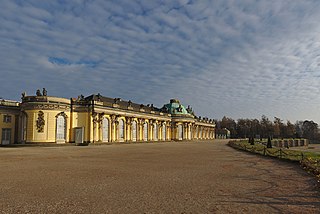
The House of Hohenzollern is a German royal dynasty whose members were variously princes, electors, kings and emperors of Hohenzollern, Brandenburg, Prussia, the German Empire, and Romania. The family came from the area around the town of Hechingen in Swabia during the late 11th century and took their name from Hohenzollern Castle. The first ancestors of the Hohenzollerns were mentioned in 1061.

Potsdam is the capital and largest city of the German state of Brandenburg. It directly borders the German capital, Berlin, and is part of the Berlin/Brandenburg Metropolitan Region. It is situated on the River Havel some 25 kilometres southwest of Berlin's city centre.

Frederick William IV, the eldest son and successor of Frederick William III of Prussia, reigned as King of Prussia from 7 June 1840 to his death on 2 January 1861. Also referred to as the "romanticist on the throne", he is best remembered for the many buildings he had constructed in Berlin and Potsdam as well as for the completion of the Gothic Cologne Cathedral.

The University of Königsberg was the university of Königsberg in East Prussia. It was founded in 1544 as the world's second Protestant academy by Duke Albert of Prussia, and was commonly known as the Albertina.

The Order of the Black Eagle was the highest order of chivalry in the Kingdom of Prussia. The order was founded on 17 January 1701 by Elector Friedrich III of Brandenburg. In his Dutch exile after World War I, deposed Emperor Wilhelm II continued to award the order to his family. He made his second wife, Princess Hermine Reuss of Greiz, a Lady in the Order of the Black Eagle.

Hohenzollern Castle is the ancestral seat of the imperial House of Hohenzollern. The third of three hilltop castles built on the site, it is located atop Mount Hohenzollern, above and south of Hechingen, on the edge of the Swabian Jura of central Baden-Württemberg, Germany.

Heinrich Ludwig Ferdinand von Arnim was a German architect and watercolour-painter. He was a student of Karl Friedrich Schinkel and mainly worked in Berlin and Potsdam.

Friedrich Ludwig Persius was a Prussian architect and a student of Karl Friedrich Schinkel.

The Orangery Palace is a palace located in the Sanssouci Park of Potsdam, Germany. It is also known as the New Orangery on the Klausberg, or just the Orangery. It was built on behest of the "Romantic on the Throne", King Friedrich Wilhelm IV from 1851 to 1864.

The Protestant Church of the Redeemer is located to the south of the village of Sacrow, which since 1939 has been incorporated to Potsdam, the capital of the German Bundesland of Brandenburg. It is famous for its Italian Romanesque Revival architecture with a separate campanile and for its scenic location. It was built in 1844. The design was based on drawings by King Frederick William IV of Prussia, called the Romantic on the Throne. The building was realized by Ludwig Persius, the king's favorite architect.

The Protestant Church of Peace is situated in the Marly Gardens on the Green Fence in the palace grounds of Sanssouci Park in Potsdam, Germany. The church was built according to the wishes and with the close involvement of the artistically gifted King Frederick William IV and designed by the court architect, Ludwig Persius. After Persius' death in 1845, the architect Friedrich August Stüler was charged with continuing his work. Building included work by Ferdinand von Arnim and Ludwig Ferdinand Hesse also. The church is located in the area covered by the UNESCO World Heritage Site Palaces and Parks of Potsdam and Berlin.

Charlottenhof Palace or Charlottenhof Manor is a former royal palace located southwest of Sanssouci Palace in Sanssouci Park at Potsdam, Germany. It is best known as the summer residence of Crown Prince Frederick William. Today it is maintained by the Prussian Palaces and Gardens Foundation Berlin-Brandenburg.

Peter Joseph Lenné was a Prussian gardener and landscape architect. As director general of the Royal Prussian palaces and parks in Potsdam and Berlin, his work shaped the development of 19th-century German garden design in the Neoclassical style. Laid out according to the principles of the English landscape garden, his parks are now World Heritage Sites.

The Ruinenberg is a hill in the Bornstedt borough of Potsdam, located north of Sanssouci Park. In 1748, the Prussian king Frederick the Great had a water tank with a capacity of around 7,600 cubic metres (270,000 cu ft) built on top to supply the Sanssouci water features, and had it decorated with artificial ruins. From 1841 a surrounding landscape garden was laid out at the behest of King Frederick William IV of Prussia, according to plans designed by Peter Joseph Lenné.

The New Palace is a palace situated on the western side of the Sanssouci park in Potsdam, Germany. The building was begun in 1763, after the end of the Seven Years' War, under King Friedrich II and was completed in 1769. It is considered to be the last great Prussian Baroque palace.

Sanssouci is a historical building in Potsdam, near Berlin. Built by Prussian King Frederick the Great as his summer palace, it is often counted among the German rivals of Versailles. While Sanssouci is in the more intimate Rococo style and is far smaller than its French Baroque counterpart, it, too, is notable for the numerous temples and follies in the surrounding park. The palace was designed and built by Georg Wenzeslaus von Knobelsdorff between 1745 and 1747 to meet Frederick's need for a private residence where he could escape the pomp and ceremony of the royal court. The palace's name is a French phrase that translates as "without concerns", meaning "without worries" or "carefree", emphasising that the palace was meant as a place of relaxation, rather than a seat of power.

Babelsberg is the largest quarter (Stadtteil) of Potsdam, the capital city of the German state of Brandenburg. The affluent neighbourhood named after a small hill on the Havel river is famous for Babelsberg Palace and Park, part of the Palaces and Parks of Potsdam and Berlin UNESCO World Heritage Site, as well as for Babelsberg Studio, a historical centre of the German film industry and the first large-scale movie studio in the world.

Friedrich August Stüler was an influential Prussian architect and builder. His masterpiece is the Neues Museum in Berlin, as well as the dome of the triumphal arch of the main portal of the Berliner Stadtschloss.

Park Glienicke, is an English landscape garden in the southwestern outskirts of Berlin, Germany. It is located in the locality of Wannsee in the Steglitz-Zehlendorf borough. Close to Glienicke Bridge the park is open to the general public. The park is part of the UNESCO World Heritage Site Palaces and Parks of Potsdam and Berlin. Within the ensemble it is one of the five main parks, the others being Sanssouci Park, New Garden, Babelsberg Park and Peacock Island (Pfaueninsel). Regarding diversity in gardening styles within the Potsdam park ensemble Park Glienicke is only superseded by Sanssouci Park. Furthermore, it is a park especially characterized by one personality due to the intense involvement of Prince Charles of Prussia. The park covers approximately 116 hectares

























